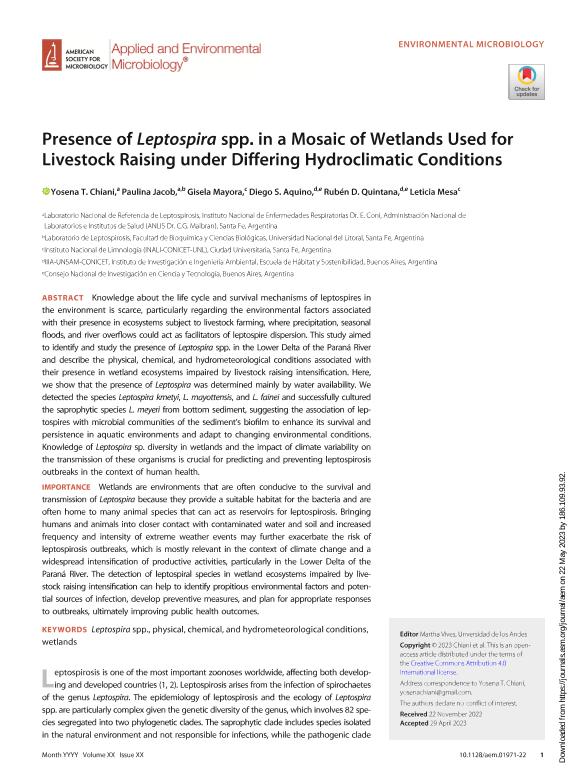Artículo
Presence of Leptospira spp. in a Mosaic of Wetlands Used for Livestock Raising under Differing Hydroclimatic Conditions
Chiani, Yosena; Jacob, Paulina; Mayora, Gisela Paola ; Aquino, Diego Sebastián
; Aquino, Diego Sebastián ; Quintana, Ruben Dario
; Quintana, Ruben Dario ; Mesa, Leticia Mariana
; Mesa, Leticia Mariana
 ; Aquino, Diego Sebastián
; Aquino, Diego Sebastián ; Quintana, Ruben Dario
; Quintana, Ruben Dario ; Mesa, Leticia Mariana
; Mesa, Leticia Mariana
Fecha de publicación:
04/2023
Editorial:
American Society for Microbiology
Revista:
Applied and Environmental Microbiology
ISSN:
0099-2240
Idioma:
Inglés
Tipo de recurso:
Artículo publicado
Clasificación temática:
Resumen
Knowledge about the life cycle and survival mechanisms of leptospires in the environment is scarce, particularly regarding the environmental factors associated with their presence in ecosystems subject to livestock farming, where precipitation, seasonal floods, and river overflows could act as facilitators of leptospire dispersion. This study aimed to identify and study the presence of Leptospira spp. in the Lower Delta of the Paraná River and describe the physical, chemical, and hydrometeorological conditions associated with their presence in wetland ecosystems impaired by livestock raising intensification. Here, we show that the presence of Leptospira was determined mainly by water availability. We detected the species Leptospira kmetyi, L. mayottensis, and L. fainei and successfully cultured the saprophytic species L. meyeri from bottom sediment, suggesting the association of leptospires with microbial communities of the sediment's biofilm to enhance its survival and persistence in aquatic environments and adapt to changing environmental conditions. Knowledge of Leptospira sp. diversity in wetlands and the impact of climate variability on the transmission of these organisms is crucial for predicting and preventing leptospirosis outbreaks in the context of human health. IMPORTANCE Wetlands are environments that are often conducive to the survival and transmission of Leptospira because they provide a suitable habitat for the bacteria and are often home to many animal species that can act as reservoirs for leptospirosis. Bringing humans and animals into closer contact with contaminated water and soil and increased frequency and intensity of extreme weather events may further exacerbate the risk of leptospirosis outbreaks, which is mostly relevant in the context of climate change and a widespread intensification of productive activities, particularly in the Lower Delta of the Paraná River. The detection of leptospiral species in wetland ecosystems impaired by livestock raising intensification can help to identify propitious environmental factors and potential sources of infection, develop preventive measures, and plan for appropriate responses to outbreaks, ultimately improving public health outcomes.
Archivos asociados
Licencia
Identificadores
Colecciones
Articulos (IIIA)
Articulos de INSTITUTO DE INVESTIGACION E INGENIERIA AMBIENTAL
Articulos de INSTITUTO DE INVESTIGACION E INGENIERIA AMBIENTAL
Articulos(INALI)
Articulos de INST.NAC.DE LIMNOLOGIA (I)
Articulos de INST.NAC.DE LIMNOLOGIA (I)
Citación
Chiani, Yosena; Jacob, Paulina; Mayora, Gisela Paola; Aquino, Diego Sebastián; Quintana, Ruben Dario; et al.; Presence of Leptospira spp. in a Mosaic of Wetlands Used for Livestock Raising under Differing Hydroclimatic Conditions; American Society for Microbiology; Applied and Environmental Microbiology; 89; 6; 4-2023; 1-12
Compartir
Altmétricas



